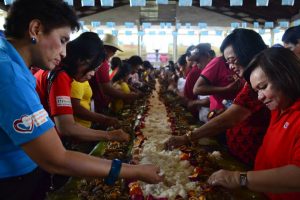
To herald the successes of Pantawid Pamilya and Sustainable Livelihood Program beneficiaries, a nationwide holiday bazaar and festival dubbed as “PaskuJuan Bazaar 2014: Salu-Salo sa Pag-babago” was staged on November 30, 2014 at the People’s Gymnasium, Tuguegarao City.
Beneficiaries displayed their products such as gift items made of indigenous materials available in their respective localities, organic fruits and vegetables and fermented products, among others.
“As in the recently concluded Pantawid Pamilya National Family Day, our beneficiaries once again proved that change can and is happening at the grassroots level and that they themselves are the agent of change,” Regional Director Remia T. Tapispisan addressed the beneficiaries, partners and guests during the said event.

Along with DSWD’s partners and other division chiefs of Field Office 2, she made the rounds during the bazaar marveling at products displayed in every booth from the different provinces in the region as well as the products brought by partner agencies such as varieties of rice by the Department of Agriculture, christmas décor and other handicrafts made by inmates at the Bureau of Jail Management and Penology, among others.
Director Tapispisan likewise shared that this event seeks to provide the beneficiaries with a venue to market their products.
The crowd were also treated to a sumptuous feast of paksiw na galunggong, pinakbet, red egg and tomatoes during the Boodle Salu-Salo. For creative and business-savvy quests, the Do-It-Yourself christmas décor made of corn husk as demonstrated by beneficiaries was a hit.
The bountiful harvest and livelihood of the beneficiaries was made possible with the capital assistance and training provided by DSWD through Sustainable Livelihood Program ( SLP).
SLP is a community-based capacity building program that seeks to improve the socio-economic status of the beneficiaries. It is implemented through the Community- Driven Enterprise Development (CDED) approach, which engages beneficiaries to actively contribute to production and labor markets by making use of available resources and accessible markets.### GELA FLOR R. PEREZ, Regional Information Officer II

